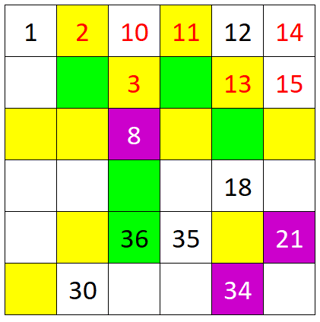Today's Hidato puzzle has a pretty complex twist. What is the twist, you ask?
This is what the twist is:
There are three different colors:
- Yellow: Represents a prime number
- Green: Represents a square number ($\sqrt x$ must produce a number $\alpha$ with $\alpha\in\mathbb N$)
- Purple: Represents a number in the Fibonacci Sequence if that number is not already represented with another color.
Also, there are only 6 numbers to begin with.
Here is the puzzle:
The goal of Hidato is to fill the grid with a series of consecutive numbers adjacent to each other orthogonally or diagonally. All tiles are required to be filled in.
I have tested this out, and am able to confirm that this truly does have only one unique solution. (took me around 5 minutes)
Text version for colorblind users (best I could do, if someone could make this better then please do unless this is good enough):
-------------------------
|1 |Y | |Y |12 | |
-------------------------
| |G |Y |G |Y | |
-------------------------
|Y |Y |P |Y |G |Y |
-------------------------
| | |G | |18 | |
-------------------------
| |Y |G36|35 |Y |P |
-------------------------
|Y |30 | | |P | |
-------------------------





